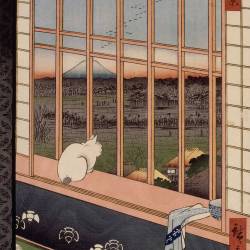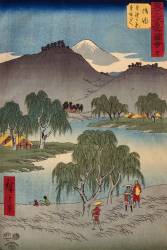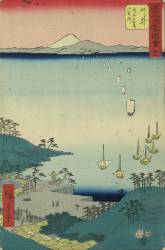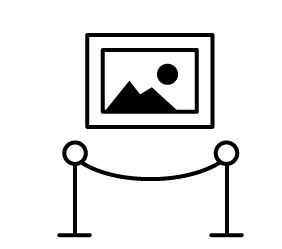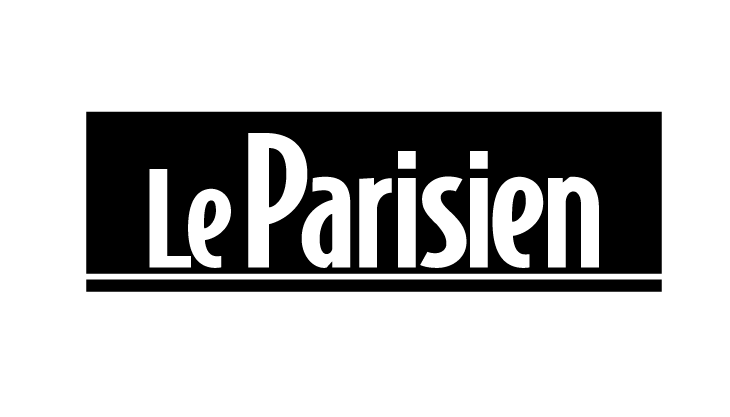Artwork of Hiroshige artprints & posters
An essential artist of Japanese art, Hiroshige used his luminous, poetic technique to bring the art of the print and the meisho-e to its apogee, even acting as a relay for Japanese painting in Europe, inspiring key Impressionist painters such as Van Gogh and Monet. With works depicting Japan like an Edo period poster, Hiroshige's legacy paints a unique picture of this 19th-century period.
Discover the works of Utagawa Hiroshige too, with Fifty-three Stations of the Tōkaidō, prints from his series of 53 paintings showing a view of the Japanese province through the country's most important traffic artery, Thirty-six Views of Mount Fuji, a series of landscapes around Japan's highest mountain, in which snow, water and cherry blossoms are poetically depicted, or One Hundred Views of Edo, one of the most famous series of ukiyo-e and meisho-e prints.
Hiroshige's early years and artistic beginnings
Andô Hiroshige, the master of Japanese prints, was born in Edo (formerly Tokyo) in 1797. Born into a family of samurai in the service of the shogun, he developed a passion for drawing at an early age. Orphaned at the age of 12, he entered the Utagawa School, a prestigious institution of Japanese art, at the age of 14. He became a pupil of Utagawa Toyohiro, after whom he later took his name, and was introduced to Ukiyo-e, a popular pictorial genre depicting scenes of daily life, landscapes and portraits of courtesans. His first works, produced during this formative period, are mainly portraits of kabuki actors and women, in the style of his master.
At the same time, Hiroshige studied the styles of various artists, including Hokusai, famous for his Thirty-six Views of Mount Fuji. He began to produce landscape prints, a genre known as meisho-e (views of places renowned for their beauty), foreshadowing the masterpieces that would make him famous in the following years. Still a painter in the making, the young artist already stood out for his acute sense of observation of nature and his ability to capture the atmosphere of Edo period Japan.
Hiroshige finds his way : Landscape
In the early 1830s, Hiroshige, already renowned for his prints of warriors and kabuki actors, turned to landscapes. Inspired by meisho-e (paintings of famous places), he abandoned portraits for a more intimate view of Japan. His first series, such as Eight Views of the Surroundings of Ōmi (1834), explore landscapes and paint a picture of his native province.
Away from the precise, descriptive style of his early work, Hiroshige developed a more expressive and poetic style of drawing. He played with colours, contrasts and atmospheric effects. Snow, moon and rain became key elements in his compositions. He drew inspiration from the masters of the genre, notably Hokusai, but distinguished himself from them with a more personal and lyrical approach.
The public was quickly won over by these prints, which captured the essence of rural Japan. Series multiplied, depicting paths and travellers, bridges, waterfalls..., and relaying the wonders of Japan. Hiroshige thus became a major figure in Japanese landscape prints, a genre that was experiencing an unprecedented boom in the country at the time. His works, printed in hundreds of copies, were distributed throughout the country, helping to popularise the image of a picturesque and poetic Japan.
The road to Tōkaidō
The Tōkaidō Road, linking Edo (present-day Tokyo) to Kyoto, was a vital artery of 19th-century Japan. Inspired by his journey in a convoy of horses to be presented to the imperial court, the painter Hiroshige immortalised it in his series of prints Fifty-three Stations of the Tōkaidō. These paintings, of which there are fifty-five, offer striking views of the landscapes crossed, the travellers encountered and the daily life that animated each station. We see horses carrying goods and travellers, processions of daimyos (feudal lords) and scenes of rural life. These works helped popularise the Tōkaidō route and confirm Hiroshige as a master of Japanese printmaking.
Hiroshige and the representation of Edo
Now recognised as a major artist of Japanese prints since his series of Fifty-three Tokaido Stations, in 1856 Utagawa Hiroshige embarked on a series featuring One Hundred Views of Edo. In one hundred and nineteen prints, he depicted the famous landmarks of Edo, with meisho-e providing a valuable record of life in the Japanese capital during the Edo period, and a poetic, intimate view of the city. Far from his usual depiction of rural landscapes, Hiroshige concentrated on Edo province and captured the unique atmosphere of the capital. His work is imbued with the sensibility of the poets and writers of his time, who influenced his vision of Japan. The One Hundred Views of Edo thus follows in the footsteps of the great Japanese print series, and contributed to Hiroshige's reputation as a master of ukiyo-e.
Other major works by Hiroshige
While Hiroshige is famous for his Fifty-three Stations of the Tōkaidō, he also immortalised other landscapes of Japan. In particular, the artist produced the Sixty-nine Stations of the Kiso Kaidō Road, a series of prints depicting the mountainous landscapes and stations of this historic road.
Among his other major works is his series of Views of Famous Sites in the Sixty-Some Provinces of Japan, a collection of seventy views of famous places across the country.
Mount Fuji is also a recurring subject in Hiroshige's work, particularly in the series Thirty-six Views of Mount Fuji, a subject already dealt with by Hokusai a few years earlier. In these meisho-e, like Hokusai, he explores through different paintings, the different aspects of this emblematic mountain under the moon, the snow or even in the midst of landscapes.
Hiroshige : The master of Ukiyo-e
A Japanese artistic movement literally meaning "images of the floating world", ukiyo-e was an art form that flourished throughout Japan between the 17th and 19th centuries. Characterised by prints accessible to as many people as possible thanks to a modest unit price, ukiyo-e celebrates the ephemeral beauty of the world, featuring courtesans, kabuki actors and landscapes.
Hiroshige stood out among many artists at the time for his series of prints, including The Fifty-Three Stations of the Tōkaidō and One Hundred Famous Views of Edo, which poetically depict the landscapes and inhabitants of the Japanese province. His bold use of colour, particularly Prussian blue, and his mastery of drawing, enabled him to create unique moods, allowing him to depict sunlight, the glow of snow or the brilliance of the moon in a unique way.
While ukiyo-e reached its apogee in the 18th century with artists such as Hokusai, Hiroshige contributed to its revival in the 19th century. Despite the decline of the movement in the face of the arrival of photography, Hiroshige's influence on Western painting was considerable, particularly on the paintings of the Impressionists. His prints also bear witness to his talent as a painter and his importance in the history of Japanese art.
Hiroshige and the opening to the West
The arrival of Japanese prints in Europe, around 1856-1858, marked a major turning point in the history of Western art. Sold at low unit prices, these editions fascinated with their bright colours, bold compositions and unusual subjects. Japanese art, with its flattened perspectives and innovative framing, offers a new way of looking at the world.
As a master of depicting landscapes and everyday life, Hiroshige had a direct and profound influence on the Impressionist painters and the Japonism movement. His bridges, cherry blossoms and views of Mount Fuji can be found in the paintings of French painter Claude Monet, such as with the painting The Japanese Bridge and the painting of The Japanese Woman, or in Van Gogh's famous Iris and Almond Tree in Bloom. Western artists were inspired by Hiroshige's prints, reinterpreting his motifs and techniques in their own paintings and posters. Hiroshige's painting thus became a bridge between two cultures, opening a page to new forms of artistic expression.
Hiroshige's legacy, an enduring influence
Utagawa Hiroshige, the master of Japanese prints, died in 1858, leaving behind a colossal legacy. His series of prints depicting Edo and the Japanese provinces revolutionised landscape art, painting a picture of everyday life and the natural beauty of Edo period Japan. Sold at low unit prices, these works democratised art, transforming the print into a medium accessible to all.
After his death, Japanese prints, thanks in particular to Hiroshige, conquered the West. Its bold compositions, subtle play of colour and innovative points of view had a profound influence on modern art. Van Gogh and Monet, and other famous Impressionist painters, were inspired by his prints, incorporating the Japanese artist's compositional principles and distinctive aesthetic into their paintings.
The influence of the Japanese cartoonist and painter is still felt today in contemporary art. Many artists, painters, graphic designers and illustrators draw on his work and Japanese art as an inexhaustible source of inspiration, reinventing his legacy through painting, posters and other editions. The bridge between Edo and the modern world, drawn by Hiroshige, remains more relevant than ever as a page in modern art.
The characteristics of Hiroshige's art, a visionary artist
Hiroshige, as a master of Japanese printmaking, is distinguished by a unique style in which the finesse of his drawing blends with a bold use of colour. His precise, delicate line brings to life landscapes imbued with poetry, from snow-capped Mount Fuji to bridges bathed in moonlight.
His painting, often described as "meisho-e", captures the essence of Japan's famous places, immortalising relays and villages in compositions where nature is omnipresent. Hiroshige excelled in the art of printmaking, his "paintings" printed in multiple editions, broadcasting powerful images like a poster of reality. Flowers, snow, or rain, he mastered the elements to create unique atmospheres.
While Hokusai focused on movement, Hiroshige concentrated on atmosphere. His subtle, transparent artistic paste gave his works a depth and luminosity that would influence Impressionist painters such as Van Gogh and Monet. The latter, fascinated by his prints, would draw inspiration from them for their own landscapes and colour schemes, bridging the gap between Western and Japanese art.
Learn more about the life and the works of Hiroshige.

